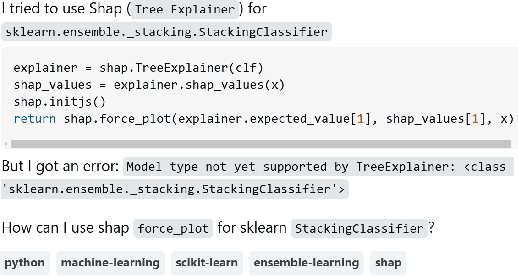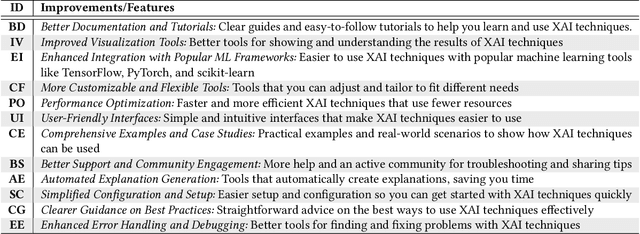Banani Roy
From Questions to Insights: Exploring XAI Challenges Reported on Stack Overflow Questions
Apr 03, 2025



Abstract:The lack of interpretability is a major barrier that limits the practical usage of AI models. Several eXplainable AI (XAI) techniques (e.g., SHAP, LIME) have been employed to interpret these models' performance. However, users often face challenges when leveraging these techniques in real-world scenarios and thus submit questions in technical Q&A forums like Stack Overflow (SO) to resolve these challenges. We conducted an exploratory study to expose these challenges, their severity, and features that can make XAI techniques more accessible and easier to use. Our contributions to this study are fourfold. First, we manually analyzed 663 SO questions that discussed challenges related to XAI techniques. Our careful investigation produced a catalog of seven challenges (e.g., disagreement issues). We then analyzed their prevalence and found that model integration and disagreement issues emerged as the most prevalent challenges. Second, we attempt to estimate the severity of each XAI challenge by determining the correlation between challenge types and answer metadata (e.g., the presence of accepted answers). Our analysis suggests that model integration issues is the most severe challenge. Third, we attempt to perceive the severity of these challenges based on practitioners' ability to use XAI techniques effectively in their work. Practitioners' responses suggest that disagreement issues most severely affect the use of XAI techniques. Fourth, we seek agreement from practitioners on improvements or features that could make XAI techniques more accessible and user-friendly. The majority of them suggest consistency in explanations and simplified integration. Our study findings might (a) help to enhance the accessibility and usability of XAI and (b) act as the initial benchmark that can inspire future research.
Comparative Analysis of Quantum and Classical Support Vector Classifiers for Software Bug Prediction: An Exploratory Study
Jan 08, 2025Abstract:Purpose: Quantum computing promises to transform problem-solving across various domains with rapid and practical solutions. Within Software Evolution and Maintenance, Quantum Machine Learning (QML) remains mostly an underexplored domain, particularly in addressing challenges such as detecting buggy software commits from code repositories. Methods: In this study, we investigate the practical application of Quantum Support Vector Classifiers (QSVC) for detecting buggy software commits across 14 open-source software projects with diverse dataset sizes encompassing 30,924 data instances. We compare the QML algorithm PQSVC (Pegasos QSVC) and QSVC against the classical Support Vector Classifier (SVC). Our technique addresses large datasets in QSVC algorithms by dividing them into smaller subsets. We propose and evaluate an aggregation method to combine predictions from these models to detect the entire test dataset. We also introduce an incremental testing methodology to overcome the difficulties of quantum feature mapping during the testing approach. Results: The study shows the effectiveness of QSVC and PQSVC in detecting buggy software commits. The aggregation technique successfully combines predictions from smaller data subsets, enhancing the overall detection accuracy for the entire test dataset. The incremental testing methodology effectively manages the challenges associated with quantum feature mapping during the testing process. Conclusion: We contribute to the advancement of QML algorithms in defect prediction, unveiling the potential for further research in this domain. The specific scenario of the Short-Term Activity Frame (STAF) highlights the early detection of buggy software commits during the initial developmental phases of software systems, particularly when dataset sizes remain insufficient to train machine learning models.
Evaluating the Performance of a D-Wave Quantum Annealing System for Feature Subset Selection in Software Defect Prediction
Oct 21, 2024



Abstract:Predicting software defects early in the development process not only enhances the quality and reliability of the software but also decreases the cost of development. A wide range of machine learning techniques can be employed to create software defect prediction models, but the effectiveness and accuracy of these models are often influenced by the choice of appropriate feature subset. Since finding the optimal feature subset is computationally intensive, heuristic and metaheuristic approaches are commonly employed to identify near-optimal solutions within a reasonable time frame. Recently, the quantum computing paradigm quantum annealing (QA) has been deployed to find solutions to complex optimization problems. This opens up the possibility of addressing the feature subset selection problem with a QA machine. Although several strategies have been proposed for feature subset selection using a QA machine, little exploration has been done regarding the viability of a QA machine for feature subset selection in software defect prediction. This study investigates the potential of D-Wave QA system for this task, where we formulate a mutual information (MI)-based filter approach as an optimization problem and utilize a D-Wave Quantum Processing Unit (QPU) solver as a QA solver for feature subset selection. We evaluate the performance of this approach using multiple software defect datasets from the AEEM, JIRA, and NASA projects. We also utilize a D-Wave classical solver for comparative analysis. Our experimental results demonstrate that QA-based feature subset selection can enhance software defect prediction. Although the D-Wave QPU solver exhibits competitive prediction performance with the classical solver in software defect prediction, it significantly reduces the time required to identify the best feature subset compared to its classical counterpart.
Unveiling the potential of large language models in generating semantic and cross-language clones
Sep 12, 2023


Abstract:Semantic and Cross-language code clone generation may be useful for code reuse, code comprehension, refactoring and benchmarking. OpenAI's GPT model has potential in such clone generation as GPT is used for text generation. When developers copy/paste codes from Stack Overflow (SO) or within a system, there might be inconsistent changes leading to unexpected behaviours. Similarly, if someone possesses a code snippet in a particular programming language but seeks equivalent functionality in a different language, a semantic cross-language code clone generation approach could provide valuable assistance. In this study, using SemanticCloneBench as a vehicle, we evaluated how well the GPT-3 model could help generate semantic and cross-language clone variants for a given fragment.We have comprised a diverse set of code fragments and assessed GPT-3s performance in generating code variants.Through extensive experimentation and analysis, where 9 judges spent 158 hours to validate, we investigate the model's ability to produce accurate and semantically correct variants. Our findings shed light on GPT-3's strengths in code generation, offering insights into the potential applications and challenges of using advanced language models in software development. Our quantitative analysis yields compelling results. In the realm of semantic clones, GPT-3 attains an impressive accuracy of 62.14% and 0.55 BLEU score, achieved through few-shot prompt engineering. Furthermore, the model shines in transcending linguistic confines, boasting an exceptional 91.25% accuracy in generating cross-language clones
 Add to Chrome
Add to Chrome Add to Firefox
Add to Firefox Add to Edge
Add to Edge